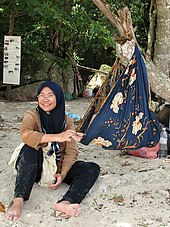Baby hammock
A baby hammock is a hammock specially adapted to the needs of an infant . There are systems with two and one point suspensions. These look noticeably different from a normal hammock for adults.
history
The history of the baby hammock is deeply rooted in cultures that focus on close contact between mother and baby. The history of the baby hammock goes hand in hand with that of the baby sling . This was often tied into a bundle and lashed to a tree to relieve the mother's back. Since the hammock was often the usual place to sleep in these cultures, its use as a baby bed is only logical. In the Mayan culture it was already normal in the pre-classical period (~ 2000 BC) to give birth in a hammock. While in parts of the Yucatán, as well as other South American regions, the hammock is still the most widespread bedstead today, its use in the western world outside of shipping has always been limited to use as relaxation furniture (for relaxing).
The baby hammock has only appeared as a replacement or addition to the bassinet in the western world since the end of the last millennium. A trend towards baby hammocks is particularly noticeable in North America and Australia.
Advantages and disadvantages of the baby hammock
Particularly when compared to an often bulky cot, the low weight, high flexibility in attachment and easy transport are advantages of a baby hammock. So it can always be used near the parents. This helps many babies sleep more soundly and longer. Especially in combination with slings or the traditional rebozos , the baby hammock promotes a strong bond with parents (see Attachment Parenting ) and thus healthy emotional development.
Another factor that speaks for a baby hammock is the relatively long period of use. Depending on the nature and load limit of the individual parts, a baby hammock can be used up to kindergarten age. The child usually only outgrows the hammock at the age of 3.
Biological and medical considerations
Most baby hammocks currently available support the rounded back recommended for babies. This so-called total cyphosis arises from the natural posture in the womb. Only after a few months does the double S-curve that enables upright walking take shape. A baby hammock makes this transition more gentle. The baby's weight is evenly distributed and the hips and the back of the head are relieved. This counteracts any deformation of the back of the head. Midwives and physical therapists recommend using a baby hammock, especially in the first few weeks and months.
Security aspects
There are currently no studies on the influence of baby hammocks on the incidence of sudden infant deaths . To reduce the risk, the same behavioral measures apply to the baby hammock as to any bedding.
swell
- ^ Y. Lefeber, HWA Voorhoeve: Indigenous customs in childbirth and child care. Van Gorcum, Assen 1998, ISBN 90-232-3366-2 , p. 28.
- ↑ Urs A. Hunziker, Ronald G Barr: Increased Carrying Reduces Infant Crying: A Randomized Controlled Trial. In: Pediatrics. Volume 77, No. 5, 1986, pp. 641-648.
- ↑ Monika Bauer: Step by Step into Life: Baby's Wonderful Way to Run. Goldegg, Vienna 2009, ISBN 978-3-901880-38-4 , p. 17.
